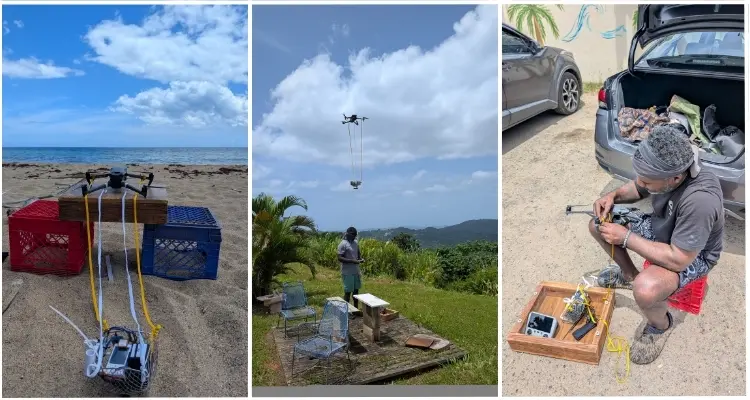LaGuardia Professors Explore The Effects of Saharan Air Dust Layer on Rainfall and Coral Through the DRRUM Project

LONG ISLAND CITY, NY (July 22, 2025) — Hurricane Maria, which struck Puerto Rico on September 20, 2017, caused widespread devastation across the island. The storm, a Category 4 hurricane, resulted in extensive damage to infrastructure, a humanitarian crisis, and a significant loss of life.
In 2020, LaGuardia Community College /CUNY Professor Nathan Hosannah partnered with other professors to research the “Impacts of Hurricane Maria on Land and Convection Modification Over Puerto Rico.” In their findings, they discovered the hurricane-induced land modification altered surface-atmosphere interactions, and Dr. Hosannah has continued to explore ecosystems in the Caribbean to learn more.
Dr. Hosannah, who teaches in the Math, Engineering, and Computer Science Department, and fellow LaGuardia Professor Ryan Mann-Hamilton teamed up with other scientists to study the impact of climate in the Caribbean islands with a focus on Puerto Rico. The research team received a $75,000 grant from the National Science Foundation (NSF) for the pilot project, titled The DRRUM (Dust, Rainfall, & Reefs: Understanding the Mechanisms), which investigates the intricate relationships between Saharan dust, rainfall patterns, and coral reef ecosystems in the Caribbean, with a focus on Puerto Rico.
“Much of the motivation for this project stems from the relationship to Puerto Rico,” said Dr. Mann-Hamilton, a professor in the Social Science Department. “Nathan has worked on the island on various projects since 2015. I was born and raised in Mayaguez, PR, and am constantly looking for ways to engage with my community and support its wellbeing. This was also an opportunity to extend our networks of collaborators and provide students with opportunities for research and travel.”
Dr. Mann-Hamilton says while the Saharan Air Layer (SAL) is known to influence regional weather, its specific effects on marine environments and local communities remain underexplored. SAL events can suppress rainfall, leading to drought conditions, and deposit both nutrients and contaminants into coastal waters. These dust intrusions have been associated with disease outbreaks in marine organisms and may degrade water quality, impacting coral reef health and coastal tourism.
To address these concerns, the DRRUM research team employed a multidisciplinary approach, combining field observations, community surveys, and advanced weather simulations. Their objectives are to: quantify the impact of Saharan dust on weather patterns and water quality, assess subsequent effects on coral reefs; and evaluate the socio-economic consequences of dust events on coastal communities in Puerto Rico.
“What surprised us was the lack of public information on the effects of the Saharan Dust Layer in Puerto Rico and across the Caribbean,” said Dr. Mann-Hamilton. “There is very little public data available and hence lackluster response from local governments. As this phenomenon increases, so do the effects not only on the population, but on agriculture, tourism, and coral reefs.”
As part of their project, seven new PurpleAir sensors were installed in the western and southern regions of Puerto Rico. Environmental Science major Lily Wong, joined the professors in Puerto Rico to install the sensors. These sensors enhance the local air quality monitoring network, providing valuable data and fostering community engagement in environmental health issues.
The organizations and locations selected were: Taller Libertà (Mayaguez); La Casa de Arte y Cultura de la Playa de Ponce (Ponce); ISER Caribe (Cabo Rojo); Finca La Marea (Mayaguez); Isla Mar Research (Rincon); Surfrider Foundation (Rincon); Isla Magueyes Research Facilities, (La Parguera). This work is supported by a grant from the National Science Foundation (NSF) and the National Center for Atmospheric Research (NCAR). The sensors real-time results can be viewed through this link.
An additional 8 sensors will be purchased and installed to expand the networks of air quality data in Trinidad and Tobago, Dominican Republic and across NYC.
“We will also be developing weather models of the SAL layer over the past 10 years to measure the changes over time,” Dr. Mann-Hamilton said. “We will also be quantifying and analyzing the responses of the 300+ surveys that we compiled about the effects of the Saharan Air Dust Layer on local populations. Once these aspects are done, we will design a web page to disseminate the findings of our project and educate the larger public.”
Learn more about this project here. Dr. Mann-Hamilton says the team hopes to expand the project with further funding if it is available.
• • • •
LaGuardia Community College (LAGCC), a Hispanic-Serving Institution, located in Long Island City, Queens offers more than 50 associate degrees and academic certificates, and more than 65 continuing education programs to prepare New Yorkers for transfer to senior colleges and rewarding jobs and careers. An institution of the City University of New York (CUNY), the College reflects the legacy of our namesake, Fiorello H. LaGuardia, the former NYC mayor beloved for his advocacy of the underserved. Since 1971, LaGuardia’s academic programs and support services have advanced the socioeconomic mobility of students from Queens, NYC and beyond.
####
